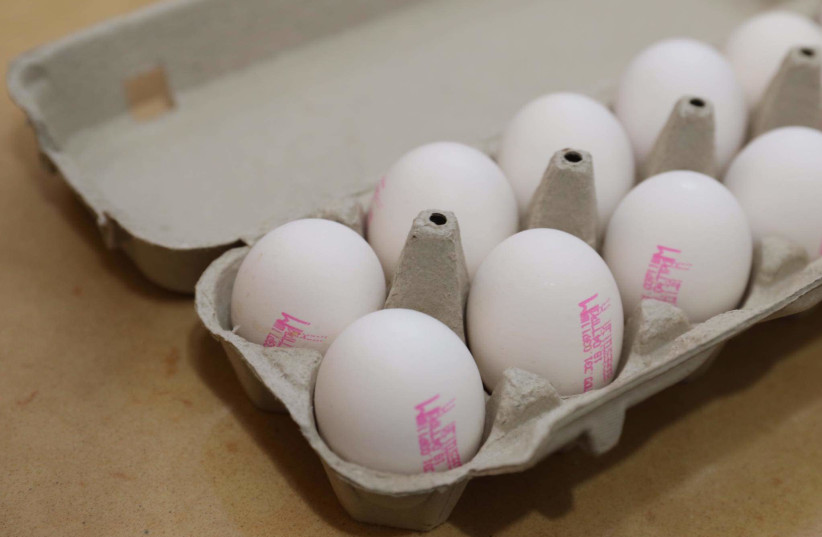Archaeological study sheds light on the size of talmudic Passover eggs

In Talmudic times, eggs were much smaller than those of today’s hens, whose size increased due to the cultivation of breeds of chickens for eggs.
After surveying some of the oldest eggs ever found in archaeological digs, Bar-Ilan University (BIU) Prof. Zohar Amar discovered they were significantly smaller than previously thought. As the Jewish holiday of Passover approaches, new questions about eggs – an important component in the festive Seder meal and as a measurement for matza have been answered.
When in history were the first eggs eaten and what size were they? The answers have emerged from a new Hebrew-language study just published in the scientific Jewish Studies Internet Journal (JSIJ) under the title “Egg measurement in the light of ancient reality” and conducted by Prof. Zohar Amar, an expert in ancient flora and fauna from BIU’s Martin department of Land of Israel studies and archaeology.
Ancient well-preserved eggs
Due to their delicacy and fragility, eggs are generally difficult to preserve and thus a rare archaeological find. In his in-depth study, Amar surveyed 15 of the most ancient, well-preserved eggs ever found in and outside of Israel.
The earliest evidence examined are large eggshells from the First Temple period uncovered during excavations of the City of David. Eggs dating to the Roman period and the Middle Ages were also studied. These eggs, completely intact, were well-preserved because they were found in septic tanks and sewage.
According to the findings of the study, chicken eggs became a significant part of the food basket only during the Hellenistic-Roman period, and their size at the time was different than thought until now. Further, Amar's analysis of historical sources revealed that the average egg volume in all periods was 40 to 44 cubic centimeters, less than that accepted in Jewish law (Halacha).
This new data may carry important halachic implications, as various rulings are determined according to the size of an egg and of an olive. If one eats an olive-sized piece of bread, one should say the blessings after meals. On Passover, one should eat a minumum of two olive-sized pieces of matza. Egg-sized measures are equivalent to two olives. On Succot, the Feast of Tabernacles, the minimum amount one should eat is also connected to the size of an egg and olives.
"The eggs are smaller than what is accepted nowadays according to the calculation of 57 cc. made by the late halachic scholar Rabbi Avraham Chaim Naeh,” explained Amar. “The late leader of ultra-Orthodox Judaism in Israel Rabbi Avraham Yeshaya Karelitz, also known as the Chazon Ish, thought that modern-day eggs were smaller and twice the size that was in the past with a volume of about 100 cc.”
Egg size increased in recent decades
The eggs’ relatively small volume existed until the middle of the 20th century. Their size and volume increased only in recent generations, following the cultivation of hen breeding.
Kebeitza is one of the most important Torah lessons, according to which the size of the minimal etrog (citron) that is kosher for using on Succot is determined. As with the lesson on impurity of food, the main and important use of this lesson is to learn the basics on which the other volumes are calculated. The meaning of 'as an egg' in this measure is the hen’s egg, Amar wrote.
“Therefore, it seems that they began to hypothesize the useful volume measurements based on eggs in everyday life only when they became a relatively common product in the Roman 5th period, and echoes of this appear in the Talmud. Many Torah studies and discussions have discussed the issue of the egg rate and were based on various calculations and partial information,” he declared.
“In this article, I will deal only with the actual size of the egg as it is known to us from the written sources and the archaeological finds from different periods, mainly from the days of the Sages (the Roman-Byzantine period), the Middle Ages and during the development of the poultry industry in modern times," Amar wrote.
The ancients often relied on the size of the realistic egg, while the latter was based in their determination on various scholarly calculations, most of which were calculated according to the relation of the egg to the rest. But there is a very big difference between the calculation methods, which stems – among other things –, from the basic question of whether nature has changed. That is, is the ancient egg rate similar to the size of the egg nowadays or has it changed beyond recognition?”
The egg rate was not fixed like nowadays, and it may have changed according to different parameters. Although it referred to an average size, this is still a deviation range, and this average may vary from place to place, Amar wrote. “As we know, nowadays different calculation methods are accepted for the egg-in-shell rate. They changed significantly over the generations until the middle of the 20th century. Only since then has there been a certain change in their volume due to the cultivation of breeds of chickens for eggs.
The rooster in the ancient Land of Israel was the Gallus (domesticus gallus) that is native to Southeast Asia. Experts say that it was domesticated from several species of wild roosters, including the Bankiba rooster. It probably spread from the Indian region to Mesopotamia, and from there to the Land of Israel at the end of the second millennium BCE.
Jerusalem Post Store
`; document.getElementById("linkPremium").innerHTML = cont; var divWithLink = document.getElementById("premium-link"); if (divWithLink !== null && divWithLink !== 'undefined') { divWithLink.style.border = "solid 1px #cb0f3e"; divWithLink.style.textAlign = "center"; divWithLink.style.marginBottom = "15px"; divWithLink.style.marginTop = "15px"; divWithLink.style.width = "100%"; divWithLink.style.backgroundColor = "#122952"; divWithLink.style.color = "#ffffff"; divWithLink.style.lineHeight = "1.5"; } } (function (v, i) { });

